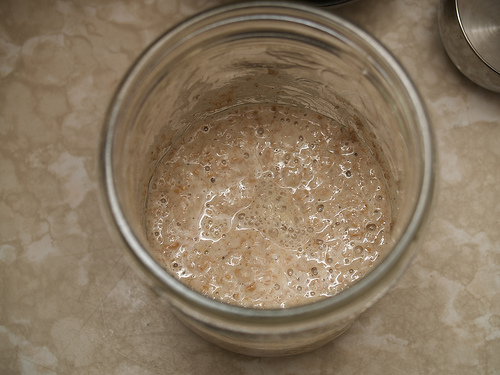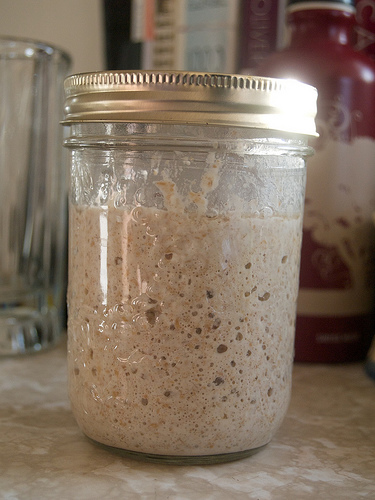It’s alive!!! It’s really alive!!! I’ve finally had some success creating a healthy sourdough starter. It’s only my second attempt, too.

I used the recipe and time frame suggested by Eric of Breadtopia, which he credits to Peter Reinhart – someone who I really need to start reading more of, because apparently he is the consummate artisanal bread guru. This recipe calls for using whole wheat flour (or any other whole grain flour, like rye, but whole wheat is what I had handy), and pineapple juice. Weird, huh? But, as Eric says in the video, the citric acid kills a specific bacteria that will thwart efforts to create a starter about 40% of the time. There was little or no action in the first 48 hours, as expected, but I fed it, as directed, and within only another 24 hours I had life! I fed it again and it doubled in size in about 12 hours. As you can see from the photos – it’s very frothy – a description I certainly would not ascribe to my last attempt.

So I fed it one more time and it thickened up and became more like a bubbly, sticky dough. I just so happened to come across a Bulk Barn yesterday so I picked up some whole rye flour and decided to take a stab at making a loaf of bread.
Since Eric had not yet led me astray, I decided to loosely follow his directions for a rustic European style whole grain loaf. I decided to use rye, whole wheat and all purpose flour (my past bread experience is that whole grain flours used alone make for a pretty tough and dense bread that I don’t much favour). Last night I set up step number one, mixing some starter with water and some more whole wheat (and in my case, whole rye) flour. The quantities Eric gives resulted in a very dense dough, and I think this may be my first mistake. I think it needed to be much more hydrated for that first twelve hours. I think some of the differences in consistency I’m experiencing are probably part flour type, and part something about Canadian flours differing from American flours – something I read somewhere once that I need to do more research on. This morning, mixing in the all purpose flour was a major challenge, since the original dough was quite dense. But I kneaded it together and hoped for the best.
Here also is where I drift from Eric’s directions, because I didn’t see the benefit of leaving the dough to rise in the fridge for 24 hours. He doesn’t explain this either. I mean, most of the reading I’ve been doing describes problems with sourdough bread rising in cooler winter kitchens, so why refrigerate? I’ve had it sitting out all day, covered in a plastic bag, with my little heating pad under the bowl to provide some gentle but constant warmth. There hasn’t been a ton of change but I’m trying not to be discouraged, yet. I know the starter was healthy and lively, so I’m going to try to have patience here and see what happens. Hopefully by tomorrow night I can report I have baked my first loaf of sourdough. If not, I guess I’ll pull the starter out of the fridge and re-feed it and start again. At least I’m halfway there with healthy starter, right?
Oh and by the way, there is a really great video, also by Eric of Breadtopia, on maintaining a starter, here.
Awesome!! I can’t wait to hear how the bread turns out… I have always wanted to have a working starter, I loooove sourdough bread.
Your starter looks great! Congratulations!
As far as refrigerators go, I wouldn’t hesitate to refrigerate the starter between feedings. Just put it in when it is very active or starting to subside, and warm it a bit before feeding it for producing something with it. As far as the refrigeration of dough goes, I would not hesitate to do it. If you buy Peter’s books, and I’d also recommend DiMuzio and Jeffrey Hamelman’s works, you will get a good education on what is happening in the refrigerator. In a nutshell, it is not only developing the dough, but developing a lot of wonderful flavors as well. The refrigerator time is called a ‘retardation’, which just means it is slowing the yeast (and lactobacillus) growth so the dough can develop flavor. It’s nice that you can spend just a few minutes producing the dough, then leave it in the fridge until baking fits your schedule the next day …and in some cases, fits your schedule any time over the next 1 to 3 days.
Brian
Thanks Brian! Unfortunately my starter never became active like this again even though it looked so good that day! I’ve kind of given up for now but will probably try again in the winter, when my schedule means I’m a bit more “at home.”
Hi,
When feeding your starter before baking (2 days) do you take out the amount of starter you want to use and feed and keep it at room temperature or do you feed the whole starter and keep it out of the refrigerator for the two day feeding period???
Hopefully you will answer right away. Thank you.
Michael J. Sims
Hi Michael, sorry for the delay in responding – I’m on vacation on Canada’s east coast.
Yes, I was feeding all the starter, then taking the amount I needed for the bread. But I have to point out that if you follow all my sourdough posts, I gave up. I only had one successful reaction with the starter after feeding it, and was never able to get a loaf of bread to work successfully. Then I just ran out of patience and gave up. Good luck!
Hi! I was surfing and found your blog post… nice! I love your blog. 🙂 Cheers! Sandra. R.
I bought a 250-year-old starter from King Arthur Flour in Vermont when I was there, and I’m trying that out now in Vancouver! Great to read your post and love the blog.